Why tiered pricing works and how to package your services to boost profitability.

Your business is well-established and you have a steady stream of income from several clients. Maybe you’ve even started to build a team with a few key hires. But, despite your success, you yearn for even more growth. The big problem, though, is you’re not sure how to scale. Let’s get straight to it, implementing a tiered pricing strategy including a built-out tiered pricing model for your services can help.
In this post, you’ll learn how using a tiered pricing model to package your services can help you scale:
- What tiered pricing and packaging services entail
- Why even bother with a tiered pricing strategy
- How to package and price your services with a 3-part framework (pricing and packaging strategies are included)
Table of Contents
Using Tiered Pricing Model To Package Your Services
At a basic level, pricing and packaging your features and services involves bundling and charging one price. Just think about the marketing agency that offers a standard service package that includes researching, writing, editing, search engine optimization, and blog post promotion for $3,500 instead of providing each service separately.
A common practice, especially among SaaS (Software as a Service) companies like FreshBooks, is to give clients the option of choosing between multiple service packages (tiered pricing). Companies usually present 3 to 5 different pricing tiers and offer incrementally more value with each subsequent tier price and feature/service package. And obviously, price tiering means higher pricing = more value.
See how FreshBooks does it below with Lite, Plus, and Premium plans—and how they also provide custom pricing (Select Plan) for clients who may have outgrown a specific package, or might be able to find additional savings due to things like high volume credit card transactions.
Of course, tiered pricing is more complex and nuanced than just creating a few packages, and slapping a price on them. Deciding what to include in each package takes time and requires an understanding of your market. On top of that setting price points and creating a pricing structure that makes sense for your business model is key to the long-term feasibility of your business.
And even once you understand your market, you need to decide how best to package your services to reflect the value that is important to clients: What services do you combine? What about packaging the service process or workflow instead of the service itself?
The good news is that your tiered pricing model need not be complex if you use the right process. There is, in fact, a 3-part framework you’ll learn about later to help you create your feature/service packages. But first, let’s explore the benefits of tiered pricing.
8 Reasons to Use a Tiered Pricing Strategy
Here are eight reasons to create tiered pricing service packages:
- Service packages make the intangible tangible
- They give prospects clarity on your offer
- Multiple packages are the perfect upsell
- Prospects don’t compare your services against the competition
- Your clients have more choice
- You appeal to prospects with different budgets
- Packages accelerate your workflow
- They help shift the focus from cost to value
A tiered pricing strategy ultimately helps you sell more services.
1. Tiered Service Packages Make the Intangible Tangible
Unlike products, services are intangible. This intangibility makes buying services riskier than purchasing products because prospects don’t know what they’re getting until they’ve tried your service. This can lead some remaining on the fence about buying your services.
Luckily, tiered pricing service packages give prospects something more tangible to justify their purchase decision. Packages “productize” your service and remove psychological barriers that prevent buying.
2. Tiered Pricing Packages Provide Clarity on Your Offer
Many business owners mistakenly list all of their services on their website and expect prospects to wade through them to determine the right service for them.
This excess of information creates choice paralysis, whereas a tiered pricing model with clear packages presents a limited number of options in a structured way. Removing these unnecessary buying obstacles can improve your chances of winning more business.
3. Multiple Pricing Tiers and Packages Help with Upselling
Your existing clients are far more likely to buy products and services from you compared to new customers. It makes sense when you think about it: They already know and have a stable relationship with you.
Existing customers are 50% more likely to buy from you and are willing to pay 31% more for your services than new customers.
But don’t take my word for it. Statistics from Invesp suggest existing customers are 50% more likely to buy from you and are willing to pay 31% more for your services compared to new customers.
To sell more services to existing clients, you need to find ways to upsell. And creating tiered pricing packages that showcase increasing value at different price points is one way to do this. For example, imagine you have 3 tiered pricing packages priced as follows:
- Package 1: $800 / month
- Package 2: $1,400 / month
- Package 3: $2,000 / month
Now also imagine that you have a client signed up for Package 1. Because they’ve already used your service and trust you, there’s less friction and hesitation to upgrade if there are compelling services in the next level up.
4. Prospects Don’t Compare You Against the Competition
A pricing structure with tiered pricing prompts prospects to compare these packages against each other instead of comparing you against the competition, which improves the odds of winning their business.
In fact, according to Bidsketch, proposals that offer tiered pricing options (for different packages) contribute to 32% more sales.
5. Customers Have More Choice
Offering tiered pricing packages gives buyers more choice, and a well-built pricing structure helps these same clients scale as their business grows.
For example, think back to FreshBooks’ tiered pricing packages: Each package targets incrementally larger businesses based on the number of billable clients, and includes features that appeal to businesses at different stages of growth.
6. Appeals to Clients with Different Budgets
Offering tiered pricing packages helps you appeal to clients with varying budgets. However, it should be noted that setting price points for your packages should take your business model, customer needs, and competitive analysis into consideration.
7. It Accelerates Your Workflow
This is an often overlooked benefit of tiered pricing. When you offer services separately, you chop up and change between different types of work and processes, even though each requires different skills. Alternating like this can overwhelm and impede workflows.
But, when you create tiered pricing packages, you set clear structures and processes for all projects that are easily replicated from one project to the next.
8. Shifts the Focus from Cost to Value
When you provide an itemized pricing model describing your services, prospects usually become cost-focused, which can lead to price haggling. But because service packages have one total price, prospects are less focused on cost and more on the value of the entire package. And, customers who think in terms of value are willing to pay far more for your services.
A Tiered Pricing Model: Your 3-Part Framework
Now that you understand what tiered pricing entails and the reasons why tiered pricing models help you scale, let’s dig into how it’s done. This section details a 3-part framework for building tiered pricing models:
- Part 1 deals with gathering information from your market to build the right kind of packages
- Part 2 details the different ways to package your services and also provides some service packaging guidelines
- Part 3 covers pricing. A discussion on service packaging wouldn’t be complete without mentioning pricing. After all, the profitability of your packages and business depends on how they’re priced
Part 1: Collecting Information to Narrow Down Your List of Services
Start gathering as much information as you can from your customers, market, competition, and business. This process helps you determine what services to bundle together and ensures you only offer relevant services to your market and potential customers.
1. Research Your Customers
Rachel Kurzyp, a business owner recently featured on the Flying Solo podcast, detailed how she made the bold decision to revamp her website and offer service packages targeted at freelancers. A big move considering she has several big clients like the World Bank.
You see, Rachel started receiving an overwhelming number of requests for help from freelancers in the professional community. In one week alone she spent 15 hours helping freelancers! She also discovered that most of her potential clients would only look at her social proof—testimonials and client logos—when choosing her services.
As a result, she knew she could confidently reposition her website to target this new segment to boost sales without losing existing business—as long as she kept her social proof. So, she created new service packages aimed at solving freelancers’ problems—all of which are now prominently displayed on her website:
Rachel’s story underscores the importance of paying careful attention to—and collecting information from—your customers when creating your service packages.
So, when deciding how to build your service packages, listen to your market. Speak to your clients and prospects. Engage in conversations to learn about their core problems. Review what services they’re currently buying. Revisit what they purchased when you started working together and see if those needs may have changed.
2. Analyze Your Own Business
Another way to determine what types of services to combine is to review your own business:
- Reflect on past projects to see what worked, what didn’t, and what you want to keep. You’ll likely discover certain services aren’t worth keeping given your earnings vs. time spent.
- Review your past sales to determine what services to keep and what services to cut. Chances are, you’ll probably find that some services bring in more revenue and profits compared to others.
- Use tools and reports in accounting software like FreshBooks to better understand things like profitability and cash flow to help inform your decisions.
3. Research Competitors
Finally, research your competition to see what services and packages they offer. Use this research to find ideas and insights for creating your own service packages. Examine how they separate their features and services, what workflows they’re building within each package, and what value they’re bringing to higher-priced packages vs ones with a lower price.
Part 2: Building Your Service Packages
Once you’ve narrowed down the list of services, it’s time to build your packages. The following section details 3 packaging strategies and provides guidelines to help you build your packages.
Packaging Strategies: 3 Ways to Package Your Services
1. Bundle Services Together
This strategy is suitable when the needs of your target markets change or when prospective customers begin to compare your services against the competition based on price.
With this strategy, you bundle together several services to create a more robust and convenient offer for your clients.
For example, you might run a content marketing agency that focuses on writing posts, eBooks, and case studies. But maybe you realize you’re relying on your clients to provide SEO research and a content strategy. That opens up an opportunity for you to expand your offering and introduce different tiers or a new up-leveled next tier.
The main features or benefits of your offering are likely getting a lot of business in the door, so consider keeping key features together in all plans makes it easier to highlight the benefits of secondary features.
2. Package Different Service Levels
This strategy caters to clients with different needs and different budgets. It also gives clients a choice and encourages the upsell.
As you saw earlier, the idea is to present several packages alongside each other to allow clients the choice of different levels of service. The packages usually range from the low- to high-end. Each package includes different deliverables and provides incrementally more value.
For instance, continuing with that same marketing agency example, the agency could present 2 extra packages:
- Starter package: Research, writing, and editing a 2,000-word blog post for $1,000 per month
- Mid-range option: All of the above, plus search engine research and optimization of the blog post for $1,600 per month
- Premium option: All of the above, plus accompanying design elements and social copy for $2,500 per month
This packaging strategy is ideal for getting clients to try your services for the first time because you have an inexpensive option positioned alongside a middle and premium one.
3. Package Your Service Processes
This is an often-overlooked method of packaging services. With this method, you package how you deliver your service to demonstrate expertise and build trust.
For example, a web design firm may decide to detail and package the steps involved in creating a website, such as a client briefing session, creating the wireframes, and so on.
Or, a landscaper may choose to detail all of the steps involved in completing a new project—from visiting the job site and compiling an estimate, to doing the actual work of hardscaping and softscaping, and getting paid by clients.
This is a little different from traditional price tiering because you’re selling the benefit as a process and not simply a single function, service, or feature.
Guidelines to Follow When Building a Tiered Pricing Structure
Regardless of what packaging or pricing strategy you choose, it’s essential to follow a few guidelines when constructing them. Here are five:
1. Double-Check That Your Packages Are Optimized
As you saw, your package should include features that matter to your audience. If you’re offering multiple packages, ensure that each subsequent edition does indeed provide incremental value.
Test your service packages by getting a client to review them and provide feedback. They’ll be able to quickly identify aspects that don’t make sense.
Also, pay attention to bigger companies and how they package their services. Whether it’s your cable provider or app subscription, there are savvy ways to get people to “up-level” their spend. Remember these big businesses have this down to a science, so study their packaging and pricing strategies.
2. Be Specific to Prevent Scope Creep
If you don’t specify what’s included in your packages, clients will eventually ask for extras they think are part of the service. Just like that, you’re having to deal with the dreaded scope creep.
By that point, you’ll have a hard time saying “no” because you realize you’re partly to blame for not specifying the deliverables up-front. That’s why you need to be specific in your package descriptions from the start.
You should still provide a comprehensive estimate or proposal to provide a detailed outline of the scope of work.
3. Naming Your Service Packages
What you choose to call your packages is up to you, but if you want them to be truly memorable, spend a little more time naming them.
Here’s a fun process you can use to start coming up with names:
- Start by writing down all of the words that come to mind when thinking about your service and business.
- Then, ask yourself: How will customers feel after using my service? Write down those emotions. Maybe they’ll feel happy, pumped up, or inspired.
- Now, list words that describe the benefits customers get from working with you. Perhaps they’ll get more sales, feel more organized or be more relaxed.
- Use online dictionaries to find synonyms and don’t be afraid to make up new ones.
- Once you have a final list of words, mix and match all of the words to see what you come up with. Remember the package names should relate to each other with a sense of progression: Think “sprout, seedling, evergreen” or “walk, run, sprint.”
Once you have a list of names, whittle down the list and choose a winner. Then, compare your chosen name against Glenn White‘s five golden rules for naming a product, which are:
- Readable and writable
- Unique
- Short, punchy, and memorable
- Look good written down and sound cool to say
- Evoke an emotion, feeling, or idea
One final note: Be sure that your names don’t “belittle” your lightest package. You don’t want people to feel small or bad for choosing that option. This is partly why “Lite” is such a common starting package—it still feels very positive.
Part 3: Pricing Your Packages
Finally, after you’ve packaged your services, it’s time to price your packages. Pricing is important because if you get it wrong, your packages can become unprofitable.
For example, if you price them in a way that leads people to cheap out, you’ll almost always sell your lowest package, which won’t help you grow like you want to.
So, how exactly do you price your service packages?
When packaging your services, the critical thing to remember is you’re forcing clients to think about the value and not the cost. This means old pricing assumptions are invalid. You can, and should, charge more for your services based on the value they now provide.
One value-based pricing strategy you can use is tiered pricing. Used when packaging different service levels, you charge an incrementally higher price to capture the subsequent increases in value.
This pricing strategy allows you to experiment with the different prices of your packages to encourage customers to purchase a specific one.
For example, you can increase the price of your low-end package relative to the middle- and high-end ones. This increase makes the latter two packages more attractive because clients now get more value for a marginally higher investment.
Also, consider the price jumps between packages. No matter how much “value” is in your second package, if it’s double the cost of the first, people will think, “It’s double!” So make those jumps feel more like organic progressions.
Finally, remember that the lowest package sets a tone for the kind of business you are and the kinds of clients you’ll attract. Your pricing should be set at a level that attracts the right kind of business, not just any and every client.
Regardless of what price you do eventually set, make sure you once again get feedback from your clients to see what they think.
What About a Volume Pricing Model?
Boiled down, a volume pricing model is a pricing structure that assigns discounts for large quantity purchases. So, in a volume pricing model, the more that is purchased at one time, the larger the discount.
Compared to tiered pricing, volume pricing gives one defined price for ALL the items or services, and the more that is purchased the more affordable they are, per unit or service.
While something to consider, most service-based businesses will find more value in tiered pricing vs volume pricing models.
Your First Few Service Packages and Beyond
Pricing and packaging your services can be tricky. There’s undoubtedly much more to the process than deciding on a few packages and putting a price to it. You need to:
- Research and understand the market to create packages that actually capture the value that’s important to your clients.
- Choose from several strategies such as bundling your services and offering different service levels.
- Follow certain service packing guidelines like providing specific service descriptions.
- Adopt a value-based pricing strategy to ensure you’re not charging based on cost.
By following the above framework, it’ll only be a matter of time before you have your first few packages and are selling more services.
But remember: The first version of your packages will not be your last. The market changes. Your client needs also change. And as a result, your service packages will probably need to change too.
We’re certainly not saying you need to update your tiered pricing model every month or quarter. What we are saying is that you should remain attuned to your ever-changing client needs and, at the very least, review them yearly and revise as needed.
The only remaining question is: Are you ready to package and price your services?
This post was updated in May 2021.

Written by Daniel Reiter, Former Editor-in-Chief, FreshBooks
Posted on September 30, 2019
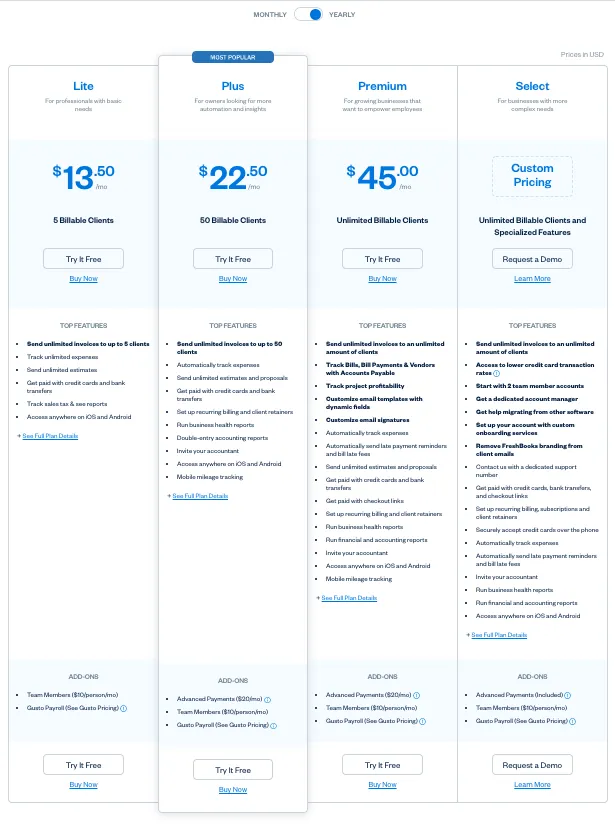
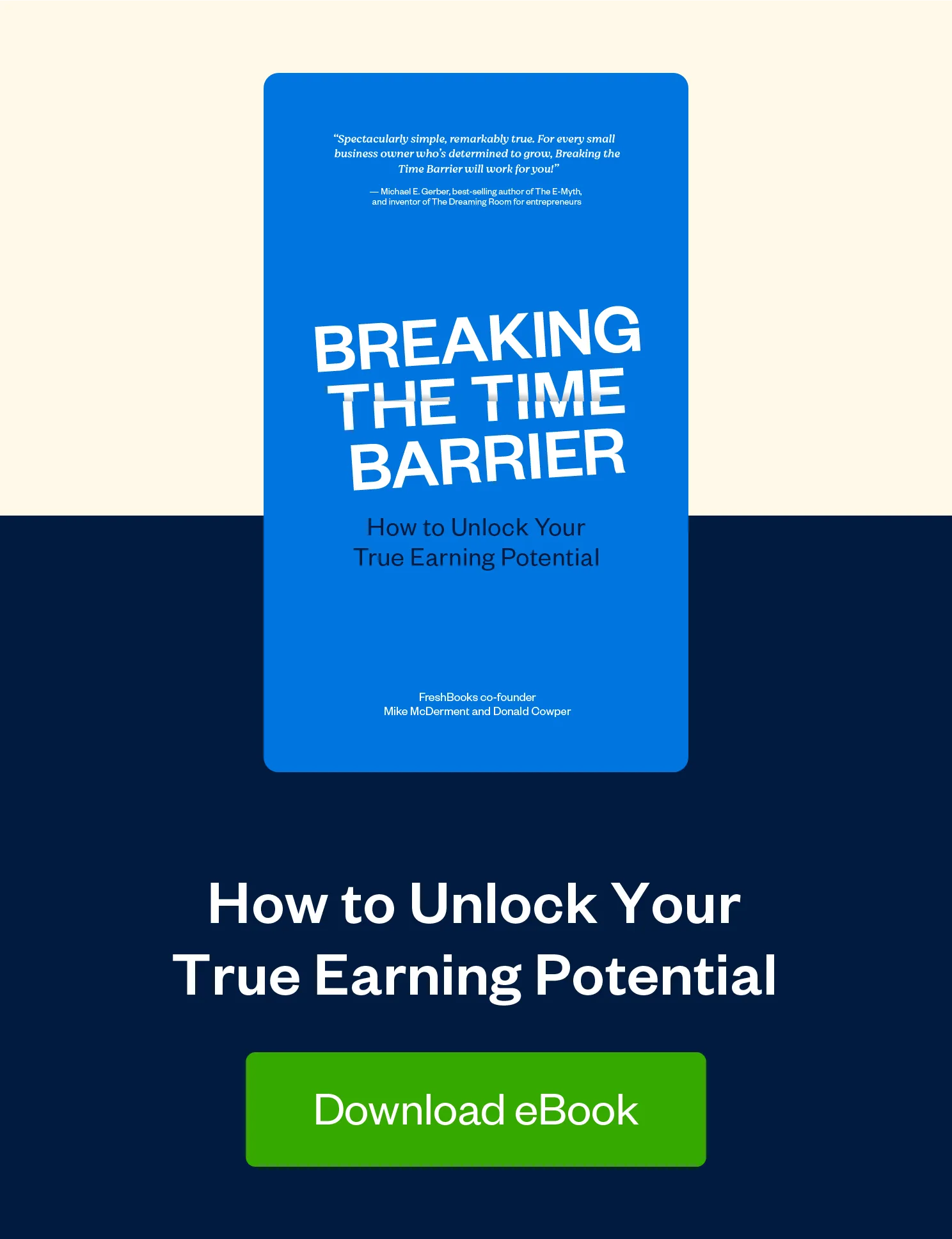

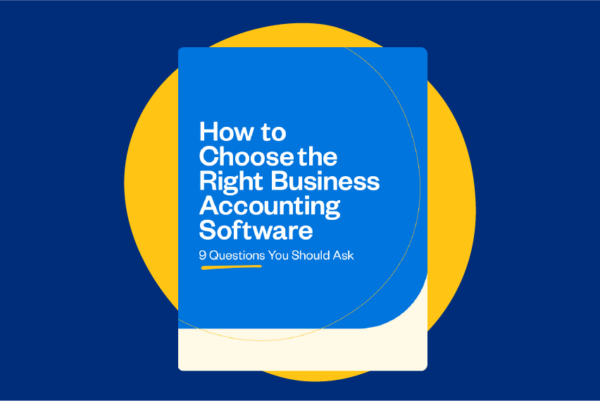 Choosing an Accounting Tool? Here’s the Buying Checklist You Need
Choosing an Accounting Tool? Here’s the Buying Checklist You Need Automated Billing: How Growing Businesses Are Managing a Large Customer Base
Automated Billing: How Growing Businesses Are Managing a Large Customer Base![6 Smart Steps to Future-Proof Your Business [Free eBook] cover image](https://prod-blog-k8s.freshenv.com/blog/wp-content/uploads/2019/04/shutterstock_1283682706-1-600x398.jpg) 6 Smart Steps to Future-Proof Your Business [Free eBook]
6 Smart Steps to Future-Proof Your Business [Free eBook]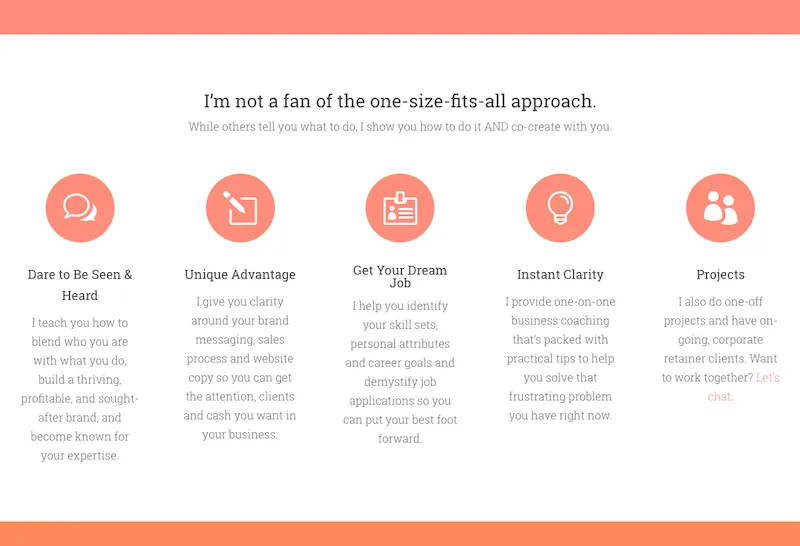
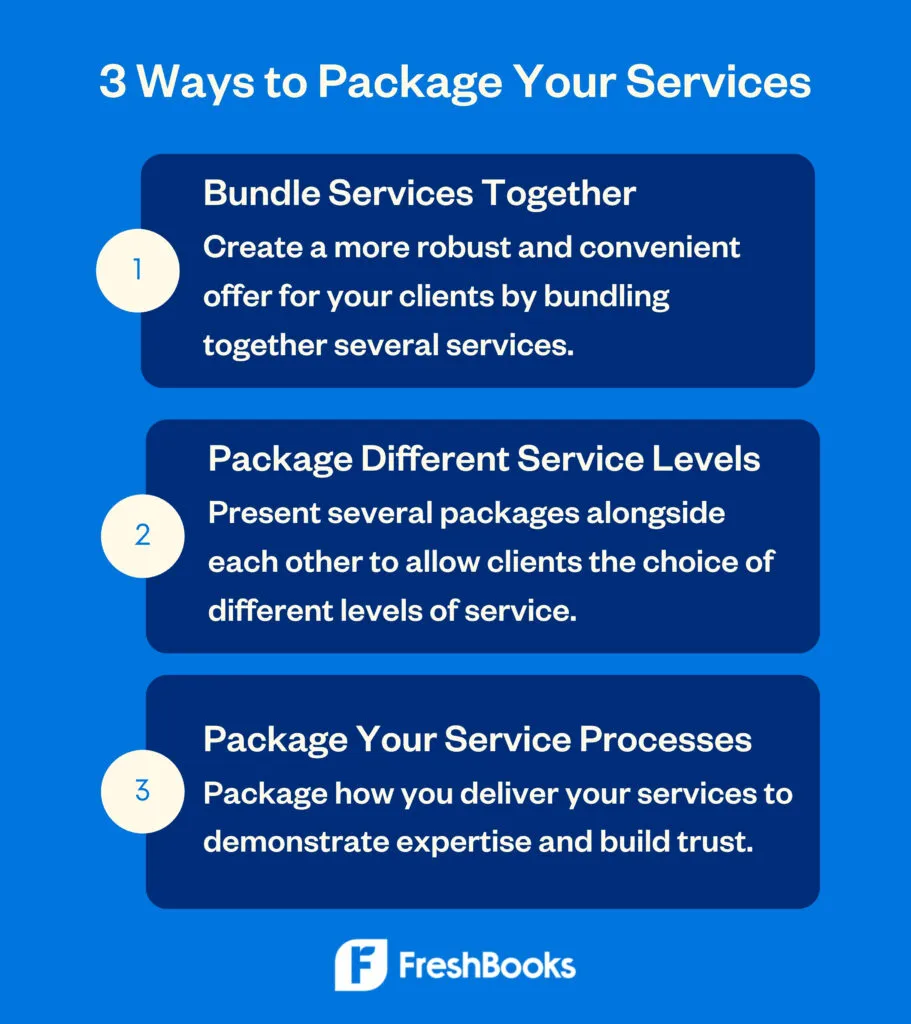
 How FreshBooks Select Helps Michael Focus and Provide a Great Experience for His Customers
How FreshBooks Select Helps Michael Focus and Provide a Great Experience for His Customers Delegate or Drown: How Delegation Empowers Your Team and Strengthens Your Business
Delegate or Drown: How Delegation Empowers Your Team and Strengthens Your Business 9 Ways Accurate Accounting Can Increase Your Business’ Value
9 Ways Accurate Accounting Can Increase Your Business’ Value





